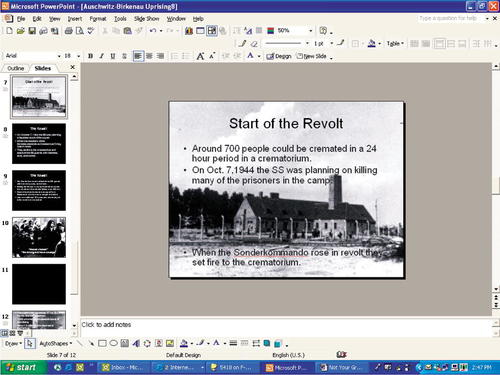Points of View: PowerPoint in the Classroom
When I was in 10th grade, my school got its first overhead projector. My teacher, Mrs. Bankston, loved that new projector; she sat right beside it and taught to it all day long. Before that, she'd written all the theorems and proofs on the chalkboard. The overhead projector was basically the same as the chalkboard, except that now, she wrote on the overhead's glass plate with black paste pens. I'm not sure whether Mrs. Bankston was, as a presenter, any more effective when she moved from the blackboard to the overhead projector. I also don't remember us being wowed by the technology; it was still the teacher droning on about something in which we weren't particularly interested. However, I know she was a lot happier with the new toy.
For student presentations (we called them “oral reports” back then), I don't remember ever using the overhead projector. Oral reports consisted of students standing before the room reading from typewritten pages. Passing around a World Book Encyclopedia with a picture was as multimedia as oral reports got. I remember giving lots of these reports, but I can't remember hearing a single one. Eventually, students started making transparencies to accompany their presentations when fancy copiers became available.
Overhead projector technology improved a lot over the years. Textbook companies started providing colorful slides, some with overlays to help demonstrate change. By the time I was teaching geometry, the slides even simulated animation with brads and arrows. I used the overhead projector a lot in my teaching, primarily because I could communicate with the students much better by facing them than by facing the chalkboard with my back to the class. But basically, my presentations were the same whether I wrote on the board or presented with transparencies.
Now, we have another presentation technology that is becoming very popular in schools, which I will refer to as “PowerPoint,” since that is by far the most common presentation software used. PowerPoint adds color, images, sound, animation, and hyperlinks to other documents, including Web documents. The increased use of PowerPoint has been very similar to that of overhead projector technology during my education. At first, teachers produced all their own slides; then, textbook companies began providing professionally created PowerPoint presentations to accompany their texts.
Just like the overhead projector before it, PowerPoint won't turn a bad presentation into a good one, and it won't convert an ineffective presenter into an effective one. Every K-12 teacher who teaches with PowerPoint or lets students use PowerPoint ought to be required to read “Powerpoint Is Evil: Power Corrupts. PowerPoint Corrupts Absolutely” (2003) by Edward Tufte. We've all endured some really bad presentations that “fancy, smancy” PowerPoint didn't save. I love Tufte's point, “If your words or images are not on point, making them dance in color won't make them relevant. Audience boredom is usually a content failure, not a decoration failure.” I've seen some presentations in which the PowerPoint overkill detracted from good content instead of supporting and enhancing it.
Figure 1. Screen shot from students' presentation in Alice Berecka's German II class; the Jewish resistance to Nazi extermination of humans. Image courtesy of the author.
Tufte makes a strong case against having students just write in bullets—what he calls the “PowerPoint Cognitive Style”—to which I say a hearty amen. Students should write oral reports in complete sentences, and they should present reports in complete sentences. I've heard students giving PowerPoint presentations in which they actually read the titles and bullets. Sometimes we literally have to hide the bullet points to force the students to talk in complete sentences rather than in clauses. But, obviously, what is really evil is not PowerPoint but its misuse, which Tufte has described so cleverly.
I think this PowerPoint Point of View is coming at a very appropriate time. Many more teachers are acquiring data projectors in their classroom, making PowerPoint available to them on a full-time basis (see attached 10th-grade geometry sample file). For example, in 2003, my school district (Sinton ISD; http://www.sintonisd.net/) received a Technology Applications Readiness Grants for Empowering Texas (TARGET) grant, which is putting laptops and liquid-crystal display (LCD) projectors in teachers' classrooms. All across the nation, millions of dollars are being spent on technology. A Houston teacher told me a couple of years back, “All our students are getting laptops and now we are desperate to figure out something for them to do on them.” In our TARGET program, we stress the opposite; let the curriculum, not the technology, drive the instruction.
For example, below are selected items from the ninth-grade “English Texas Essential Knowledge and Skills,” the state-mandated curriculum.
(7) Reading/comprehension. The student comprehends selections using a variety of strategies. The student is expected to:
(F) identify main ideas and their supporting details;
(G) summarize texts;
(H) draw inferences such as conclusions, generalizations, and predictions and support them from text;
Creating a title and bullet points on a PowerPoint slide helps students identify main ideas and their supporting details. Let me emphasize again that bullet points should not replace complete sentences, but they can help students structure their thinking.
K-12 students tend to enjoy working with PowerPoint; they like adding images, sound, and animation to illustrate their text. We can use their enjoyment to motivate skill developments that they find less enjoyable. Motivation is a key factor in K-12 education. The bitter-pill model (“Do this, it's good for you!”) doesn't work very well, especially with reluctant learners. PowerPoint may be the spoonful-of-sugar-makes-the-medicine-go-down model, though I'm not sure I like that as a teaching philosophy. I wish all students absolutely loved finding main ideas and summarizing texts, but they don't.
PowerPoint is by no means the only software that could support these skills and is probably not the best. Inspiration®, for example, is a tool designed to develop ideas and organize thinking and to support critical thinking, comprehension, and writing in all curriculum areas. But PowerPoint is here to stay; it's Microsoft after all, and in many school systems, there isn't enough money for specialized software.
I've seen horrific K-12 student presentations in PowerPoint, and I've seen great ones. Yesterday, I saw a beautifully moving presentation on the 1940s Jewish resistance movement (Figure 1). I hope this will become the rule, rather than the exception.



